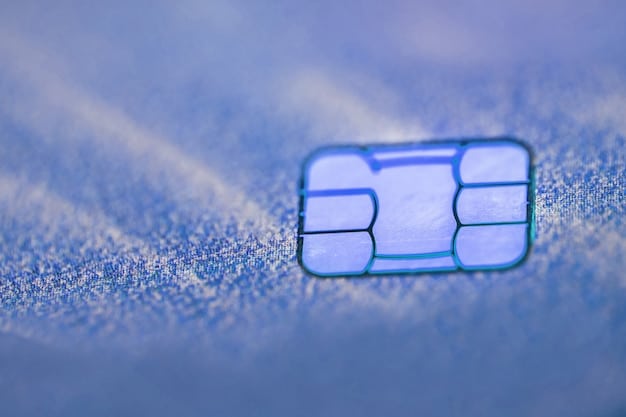Unlocking Hidden Value: Redeem Credit Card Points for 1.5 Cents+ in 2025

Redeeming credit card points for 1.5 cents per point or more in 2025 involves strategic planning, primarily leveraging transferable points programs, airline partners for premium travel, and select hotel redemptions to maximize their inherent value beyond simple cashback.
In the evolving landscape of credit card rewards, understanding how to maximize the value of your hard-earned points is paramount. We delve into strategies for Unlocking Hidden Value: How to Redeem Credit Card Points for 1.5 Cents Per Point or More in 2025, transforming everyday spending into extraordinary experiences and substantial savings.
Understanding the True Value of Your Points
The inherent value of a credit card point isn’t static; it fluctuates significantly based on how diligently you redeem it. While many cards offer straightforward cash back at 1 cent per point, savvy consumers know there are pathways to dramatically increase this valuation, often reaching 1.5 cents, 2 cents, or even higher, especially when applied to travel.
Maximizing point value requires a nuanced understanding of loyalty programs and their intricate redemption schemes. It’s about moving beyond the default options and exploring the strategic advantages that certain redemptions offer. This involves recognizing which types of points offer the most flexibility and the best transfer ratios.
The Spectrum of Point Valuations
Not all points are created equal. Some programs inherently offer more flexibility and higher potential value due to their extensive network of transfer partners. Others are more restrictive, often limiting redemptions to their own portals or a fixed cash value. Understanding this fundamental difference is the first step.
- Fixed Value Programs: Points are typically worth a set amount, often 1 cent each, when redeemed for cash back, gift cards, or purchases through the issuer’s portal.
- Travel Portal Redemptions: Points can often be redeemed for flights or hotels through the card issuer’s own travel portal, sometimes with a slight bonus (e.g., 1.25 or 1.5 cents per point).
- Transferable Points Programs: These are the gold standard, allowing points to be transferred to various airline and hotel loyalty programs, often unlocking outsized value for premium travel.
The distinction between these types of programs is crucial for anyone aiming for the 1.5 cents per point threshold or higher. Fixed-value programs rarely offer such returns, whereas transferable points programs are specifically designed to facilitate these high-value redemptions.
Why 1.5 Cents Per Point Serves as a Benchmark
The 1.5 cents per point mark is often considered a significant benchmark in the points and miles community because it represents a substantial increase over baseline cash-back redemptions. Achieving this value means you’ve successfully leveraged a program’s benefits beyond the standard offering, translating to a 50% increase in purchasing power for your points.
This benchmark also indicates that you are likely employing strategic redemption methods, such as transferring points to loyalty partners. Typically, these higher values are found when points are used for premium cabins (business or first class) on flights, or for luxury hotel stays, where the cash price would be extraordinarily high.
Leveraging Transferable Points Programs
At the heart of high-value point redemptions lie transferable points programs. These programs offer unparalleled flexibility, allowing cardholders to convert their credit card points into airline miles or hotel points at various ratios, often 1:1. This flexibility is key to unlocking values far exceeding simple cash back.
The major players in this space are Chase Ultimate Rewards, American Express Membership Rewards, Citi ThankYou Rewards, and Bilt Rewards. Each has its unique set of transfer partners, influencing the best redemption strategies for specific travel goals.

Chase Ultimate Rewards
Chase Ultimate Rewards is renowned for its valuable travel partners and user-friendly redemption portal. Points can be transferred to a diverse selection of airlines and hotels, typically at a 1:1 ratio. Popular airline partners include United Airlines, Southwest Airlines, and British Airways, while hotel partners feature Hyatt, Marriott, and IHG.
One of the most consistent ways to achieve high value with Ultimate Rewards is by transferring to Hyatt. Hyatt’s award chart often provides incredible value, particularly for luxury properties, where even standard room redemptions can easily net 2 cents per point or more against their cash price.
- Best Airline Partners for Value: United Airlines (for Star Alliance flights), British Airways (for short-haul flights to avoid high surcharges), Virgin Atlantic (for premium Delta redemptions).
- Premier Hotel Partner: World of Hyatt often provides exceptional value, especially for high-end properties, where obtaining 2 cents per point is common.
- Chase Sapphire Preferred/Reserve: These cards offer increased redemption value through the Chase travel portal (1.25 or 1.5 cents per point, respectively) even before transfers.
When considering Chase Ultimate Rewards, it’s essential to compare the cash price of a flight or hotel stay with the number of points required. This quick calculation helps determine if a specific redemption will yield the desired 1.5 cents per point or higher.
American Express Membership Rewards
American Express Membership Rewards boasts the largest array of transfer partners among all transferable points programs. This extensive network includes major airline alliances and independent carriers, as well as a selection of hotel chains. However, transfer ratios vary, and some partners may not always be 1:1.
The key to maximizing Amex points lies in leveraging their frequent transfer bonuses, which can add an extra 10% to 40% to your transferred points. These bonuses can transform an already good redemption into an excellent one, easily pushing the value past 1.5 cents per point.
- Frequent Transfer Bonuses: Keep an eye out for these promotions, typically occurring throughout the year, which can significantly boost your point value.
- Airline Partners for Premium Travel: Delta Skymiles (though value can vary), Air Canada Aeroplan (for Star Alliance), ANA Mileage Club (for premium long-haul flights), British Airways Executive Club.
- Strategic Hotel Transfers: While not as consistently lucrative as Hyatt for Chase, certain Hilton or Marriott transfers can offer good value during promotions or for specific luxury stays.
Amex points are particularly powerful for international premium cabin travel, where the cash cost of a ticket can be prohibitive but award space can be found at a fraction of the price in points.
Citi ThankYou Rewards
Citi ThankYou Rewards has significantly enhanced its transfer partner lineup in recent years, making it a formidable contender. Its strength lies in a diverse mix of airline partners, some of which are unique to Citi, offering distinct redemption possibilities.
Like American Express, Citi also occasionally offers transfer bonuses, though perhaps less frequently. The sweet spot for Citi points often involves transferring to partners like Avianca LifeMiles or Turkish Airlines Miles&Smiles for Star Alliance redemptions, or Singapore Airlines KrisFlyer for premium cabin award flights.
- Unique Airline Partners: Eva Air Infinity MileageLands, Qatar Airways Privilege Club, and Thai Airways Royal Orchid Plus offer niche but potentially high-value redemptions.
- Best for Star Alliance: Avianca LifeMiles and Turkish Airlines Miles&Smiles often provide competitive rates for Star Alliance flights.
- Asia-Pacific Focus: Many of Citi’s strongest partners are based in Asia, making it an excellent program for travel to and within that region.
Understanding the award charts of Citi’s partners is essential here, as some offer better value for specific routes or classes of service than others.
Bilt Rewards
Bilt Rewards is a newer player in the transferable points game, gaining rapid popularity due to its unique ability to earn points on rent payments without transaction fees. Its transfer partners are robust, including some of the most valuable options available across other programs.
The program often features favorable transfer ratios and, similar to Amex and Citi, occasionally offers transfer bonuses. Bilt’s key advantage is its integration with everyday essential spending like rent, making it easier for many to accrue a substantial amount of points quickly.
- Rent Payments: Earn points on rent, a significant monthly expense for many, often with high earning potential.
- Valuable Partners: Includes American Airlines AAdvantage, World of Hyatt, and United Airlines MileagePlus, all known for good redemption value.
- Dining Multipliers: Earns elevated points on dining, adding another avenue for accelerated accumulation.
Bilt Rewards stands out for making point collection more accessible to renters, providing a powerful tool for those looking to offset housing costs with high-value travel redemptions.
Strategic Redemption Methods for High Value
Achieving 1.5 cents per point or more isn’t just about selecting the right transferable points program; it’s about employing strategic redemption methods. This involves a deep dive into specific award charts, understanding peak versus off-peak pricing, and knowing when to capitalize on unadvertised sweet spots.
The most consistent way to secure exceptional value is by redeeming points for premium cabin international flights or high-end hotel suites that would otherwise cost thousands of dollars in cash. The perceived value here far outstrips simple cash back.
Premium Cabin Flights
Redeeming points for business or first-class flights is arguably the most effective way to maximize their value. The cash price of these tickets can be exorbitant, making point redemptions incredibly lucrative. For example, a business class ticket from the US to Europe that costs $5,000 might only require 70,000-100,000 points, yielding a value of 5-7 cents per point.
This strategy requires flexibility with travel dates and destinations, as award space in premium cabins is limited. It also often involves transferring points to a specific airline’s loyalty program.
- International Business/First Class: Look for opportunities to fly premium cabins on long-haul international routes.
- Sweet Spots in Award Charts: Research airline partners’ award charts for exceptional deals on specific routes or regions. For instance, ANA’s round-the-world award chart, or certain redemptions on Avianca LifeMiles, can offer incredible value.
- Avoid High Surcharges: Be mindful of carrier-imposed surcharges. Some airlines, like British Airways and Lufthansa, often levy significant fees on award tickets, which can dilute point value. Others, like United or Singapore Airlines, typically have lower surcharges.
The key to successful premium cabin redemptions is diligent research and booking well in advance, or conversely, looking for last-minute availability which sometimes opens up.
Luxury Hotel Stays
Similarly, using points for luxury hotel stays can significantly elevate your point valuations. Programs like World of Hyatt are consistently cited for their favorable award charts, often allowing you to book high-end properties for a relatively modest number of points compared to their cash rates.
A night at a five-star hotel that costs $800 might be available for 25,000-30,000 points, easily netting 2.5 cents per point or more. This is particularly true for city-center hotels or resort properties where cash rates are perpetually high.
- World of Hyatt: Known for their fixed award chart and consistent high value, especially at Category 6-8 properties.
- Transfer Bonuses for Hotels: While less common, some transferable point programs occasionally offer bonuses for transfers to hotel partners, which can enhance value.
- Free Night Certificates: Some credit cards offer annual free night certificates that can be used at specific hotel categories, often yielding values far in excess of the card’s annual fee.
Maximizing hotel redemptions often means identifying peak season rates that make point redemptions particularly advantageous, or finding hidden gems within an award chart.
Considering Specific Card Products and Their Benefits for 2025
The credit card landscape is dynamic, with issuers constantly updating their offerings and benefits. For 2025, several key card products continue to stand out for their ability to facilitate high-value point redemptions. Selecting the right card (or combination of cards) is crucial.
It’s not just about earning points, but about the specific redemption avenues each card unlocks. Pay close attention to annual fees versus benefits, earning multipliers, and especially how those points are valued when redeemed through the card’s proprietary portal or transferred to partners.
Chase Sapphire Preferred & Reserve
The Chase Sapphire Preferred and Sapphire Reserve are cornerstones for anyone wanting to maximize travel rewards. The Sapphire Preferred offers points redeemable at 1.25 cents per point through the Chase Travel Portal, while the Sapphire Reserve offers 1.5 cents per point.
But their true value comes from the ability to transfer points to Chase’s robust set of travel partners at a 1:1 ratio. This is where the 1.5 cents per point (or more) objective truly becomes attainable, particularly when using partners like World of Hyatt.
- Sapphire Reserve Travel Credit: Annual travel credit offsets a significant portion of its annual fee, reducing the effective cost of holding the card.
- Primary Rental Car Insurance: Provides valuable coverage that can save money and provide peace of mind.
- Dining & Travel Multipliers: Earns accelerated points on common spending categories, boosting point accumulation.
Both cards offer excellent travel protections, including trip delay insurance and baggage delay insurance, which add tangible value beyond point redemptions.
American Express Platinum & Gold Cards
The American Express Platinum Card, while having a high annual fee, offers a plethora of premium travel benefits and significant Membership Rewards earning potential on specific categories like airfare booked directly with airlines or Amex Travel. Its points are highly valuable due to Amex’s extensive transfer partner list.
The Amex Gold Card is renowned for its 4x points on US supermarkets (on up to $25,000 per calendar year) and at restaurants worldwide, making it an everyday spending powerhouse for families and foodies. The points earned can then be transferred to those same valuable airline partners.
- Amex Platinum Lounge Access: Comprehensive lounge access (Centurion, Priority Pass, Delta Sky Clubs) enhances travel experiences significantly, adding to overall value.
- Credits Galore (Amex Platinum): Various statement credits (Uber, digital entertainment, Saks, airline fee credits) can substantially offset the annual fee for those who utilize them.
- Flexible Transfer Partners: Both cards allow transfers to all Amex airline and hotel partners, unlocking diverse high-value redemptions.
For individuals who can leverage the Amex Platinum’s extensive benefits and the Gold Card’s strong earning rates, the combined power for earning and redeeming points is immense.

Avoiding Common Pitfalls and Ensuring Value
While the potential for high-value redemptions is significant, several common pitfalls can erode your point value. Being aware of these can help ensure that you consistently achieve the 1.5 cents per point benchmark or higher.
It’s vital to remember that not every transfer or redemption will yield optimal value. Due diligence is required to compare cash prices versus award costs and to understand the nuances of each loyalty program’s rules.
Understanding Point Devaluation
Loyalty programs sometimes devalue their points, meaning the same award ticket or hotel stay requires more points than before. This can happen without notice. Diversifying your points across different programs can mitigate this risk, and spending points rather than hoarding them is often advisable.
Keeping a close watch on news from credit card issuers and their loyalty partners is crucial to stay ahead of potential devaluations. Act swiftly if a valuable redemption opportunity is about to diminish.
- Don’t Hoard Points Indefinitely: Points are a depreciating asset. Use them when a good opportunity arises rather than waiting for years.
- Diversify Your Point Holdings: Avoid putting all your eggs in one basket. Spread your earnings across a few different transferable points programs.
- Stay Informed: Follow points and miles blogs and forums to be aware of impending changes to reward programs.
Regularly auditing your point balances and redemption goals can help you make timely decisions that protect your point value.
High Airline Surcharges on Award Tickets
Some airlines, particularly certain European and Asian carriers, levy substantial fuel surcharges or carrier-imposed fees on award tickets. These fees can sometimes amount to hundreds of dollars, significantly detracting from the value of your points. For example, British Airways, Lufthansa, and Air France often have high surcharges.
To avoid this, prioritize transfer partners that are known for lower (or no) surcharges on award tickets, such as United Airlines, Singapore Airlines, and Avianca LifeMiles for Star Alliance flights, or Alaska Airlines and American Airlines for Oneworld flights if booking through their respective programs.
- Research Surcharge Policies: Before transferring points, check the specific airline’s policy on award ticket surcharges.
- Choose Low-Surcharge Partners: Opt for partners that are known for minimal or no surcharges, even if it requires a different routing.
- Factor in Cash Cost: Always add the cash component (taxes and surcharges) to your point redemption calculation when determining value.
A high surcharge can quickly turn an otherwise excellent point redemption into a mediocre one, bringing the per-point value below the desired threshold.
Avoiding Redemption When Cash Price is Low
It sounds counterintuitive, but sometimes the cash price for a flight or hotel is so low that using points would actually yield poor value. For instance, a short-haul flight might cost $100 in cash but require 10,000 points. In this scenario, your points would only be worth 1 cent each, missing the 1.5 cents per point target.
Always compare the cash price of what you’re redeeming points for. If the cash price is particularly low, it might be better to save your points for a redemption where they can provide outsized value, and simply pay cash for the inexpensive item.
- Calculate Per-Point Value: Divide the cash price of the desired redemption by the number of points required. (e.g., $500 / 25,000 points = 0.02, or 2 cents per point).
- Save Points for Premium: Reserve your points for redemptions where the cash cost is significantly higher, especially premium travel.
- Consider Opportunity Cost: Think about what else you could redeem those points for. Is this the best use of your valuable points?
This disciplined approach ensures that every point redemption contributes meaningfully to your financial and travel goals.
Planning and Executing Your High-Value Redemptions
Successfully redeeming credit card points for 1.5 cents per point or more requires meticulous planning and swift execution. The best deals, particularly in premium travel, are often fleeting and require a proactive approach.
It’s not enough to simply accumulate points; understanding the booking windows, identifying award availability, and being ready to transfer points quickly are all critical components of an effective strategy for 2025.
Monitoring Award Availability
Award availability, especially for business and first-class cabins, is often limited and released in batches. Airlines typically release award seats months in advance (e.g., 330-360 days out), but also sometimes release last-minute availability as departure dates approach. Tools and alerts can help you track these.
Being flexible with your travel dates and even destinations can significantly increase your chances of finding desirable award space. Sometimes, repositioning flights (booking a separate cheap domestic flight to a major international hub) can open up more award options.
- Book in Advance: For popular routes and premium cabins, booking as soon as award calendars open is often the best strategy.
- Set Up Alerts: Use tools like ExpertFlyer or seat alerts from airlines directly to be notified when award space becomes available.
- Consider Off-Peak Travel: Traveling during shoulder season or off-peak times often yields better award availability and sometimes lower point requirements.
Consistent monitoring and patience are key ingredients in the quest for rare and valuable award redemptions.
Understanding Transfer Times
When you transfer points from your credit card issuer to an airline or hotel loyalty program, the transfer isn’t always instant. While some transfers are immediate (e.g., Chase to Hyatt), others can take anywhere from a few hours to several days (e.g., Amex to Singapore Airlines). This delay is crucial to factor into your planning.
If you find an award seat you want, it’s generally advisable to confirm with the airline that the space is still available just before initiating a point transfer, especially if the transfer is not instant. This saves you from having orphaned points in an airline program if the award disappears before your points arrive.
- Identify Instant Transfers: Know which transfers are instant versus those that take time.
- Confirm Availability: Double-check award space immediately before transferring non-instant points.
- Be Prepared for Delays: Factor in potential delays, especially for highly sought-after redemptions.
A misstep here can mean losing out on a valuable redemption, as award availability can disappear in minutes.
Maximizing Your Earning Strategy
To consistently hit high-value redemptions, you need a steady stream of points. This involves a thoughtful earning strategy beyond just everyday spending. Understanding category bonuses, welcome offers, and manufactured spending (where appropriate and within terms) can accelerate your point accumulation.
Combining the right credit cards to maximize earning on different spending categories is a common strategy among points and miles enthusiasts. For instance, using an Amex Gold for dining and groceries, a Chase Sapphire Reserve for travel, and a specific co-branded card for airline or hotel stays.
- Category Bonuses: Maximize points by using cards that offer bonus points on specific spending categories (e.g., 3x on travel, 4x on dining).
- Welcome Offers: Strategically apply for new credit cards to take advantage of valuable welcome bonuses, which are often the largest source of points.
- Referral Bonuses: If you have friends applying for cards, consider referring them for additional bonus points.
A well-thought-out earning strategy ensures you always have a healthy balance of points ready for those high-value redemption opportunities when they arise.
| Key Point | Brief Description |
|---|---|
| ✈️ Transferable Programs | Crucial for high value; enables conversion to airline and hotel partners. |
| 💼 Premium Redemptions | Airlines and luxury hotels offer the best point-per-dollar value. |
| 📚 Strategic Planning | Research programs, avoid fees, and monitor availability for best results. |
| ⏱️ Timely Action | Book in advance, understand transfer times, and act quickly on deals. |
Frequently Asked Questions About Point Redemptions
▼
Achieving 1.5 cents per point means that for every point you redeem, you’re getting $0.015 in value. For example, if you redeem 100,000 points, they are effectively worth $1,500. This is typically achieved by transferring points to airline or hotel loyalty programs for premium travel experiences, rather than simply redeeming for fixed-value cash back or gift cards.
▼
Transferable points programs like Chase Ultimate Rewards, American Express Membership Rewards, Citi ThankYou Rewards, and Bilt Rewards generally offer the best opportunities for high-value redemptions. These programs allow you to transfer points to various airline and hotel partners, where you can often find redemptions at 1.5 cents per point or significantly higher, especially for premium travel.
▼
Not always. While transferring points can yield much higher value for premium travel redemptions, it’s not always the best option if your goal is primarily cash back or if cash prices for desired travel are very low. Always compare the cash value of your desired redemption to the number of points required. If the per-point value is less than 1.5 cents, consider if it’s the optimal use of your points or if cash back is more practical.
▼
To avoid high fuel surcharges, research airline partners’ policies before transferring points. Some airlines like British Airways or Lufthansa often impose significant surcharges, while others like United Airlines, Singapore Airlines (via KrisFlyer), or Avianca LifeMiles are known for lower fees on award tickets. Prioritize transferring to programs that either don’t levy these surcharges or have more reasonable ones, even if it means a slightly different travel route.
▼
The best time to book award flights for maximum value often depends on the airline and route. Generally, award seats, especially in premium cabins, are released as soon as the booking calendar opens (typically 330 to 360 days out). However, airlines may also release additional award space closer to the departure date if seats remain unsold. Flexibility with dates and being prepared to book quickly are key, as high-value award space is limited.
Conclusion
Achieving 1.5 cents per point or more for your credit card rewards is not merely a hypothetical; it’s a tangible outcome of strategic planning and informed decision-making. By prioritizing transferable points programs, meticulously researching airline and hotel partners, and executing redemptions with precision, consumers can unlock significant value from their credit card points. The journey from everyday spending to luxury travel experiences is accessible, provided you understand the nuances of the loyalty landscape and leverage the benefits each program offers effectively. Embrace the discipline of savvy redemption, and watch your points transform into unparalleled travel opportunities in 2025 and beyond.





